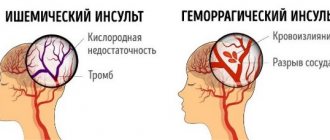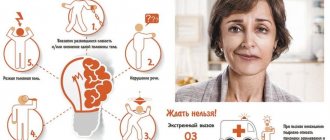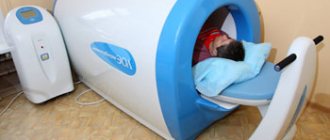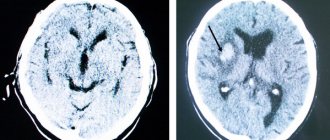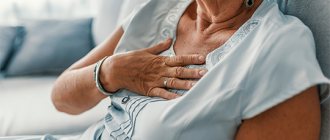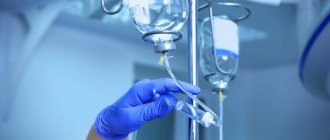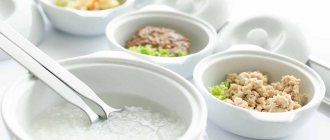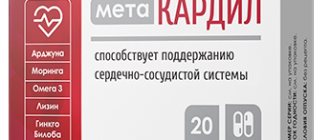Rehabilitation of a patient with ischemic brain damage begins in an inpatient setting. After emerging from the unconscious state and normalization of hemodynamic parameters, in addition to medications, the patient is prescribed diet, massage, and physical therapy. These measures are no less significant than constant medication use.
Optimal conditions for recovery are created in specialized centers, departments, and sanatoriums. There are rehabilitation specialists here: speech therapist, physiotherapist, exercise therapy instructors, psychologist, nutritionist. If the patient’s relatives cannot, for some reason, allow transfer to a sanatorium, then rehabilitation after an ischemic stroke is organized at home.
The importance of rehabilitation measures is demonstrated by statistical data: after 1.5 years, up to 85% of patients who have suffered an ischemic stroke are able to return to a standard of living approaching their usual one. This requires constant work by the patient himself and those close to him. In the first 4 months, 66% of victims achieve good results.
What periods are distinguished in rehabilitation therapy?
The sequence of rehabilitation periods is determined individually and depends on the morphological changes after ischemia in the lesion and vessels. Their duration also depends on the patient’s persistent compliance with all prescriptions at home. Most often distinguished:
- initial or early period - the first six months;
- late - up to a year;
- long-term results - more than a year.
Some rehabilitation therapists prefer 4 stages of the recovery process:
- the first month is the most dangerous for life and repeated disorders, all treatment is aimed at reducing tissue swelling, preventing compression of vital centers, stimulating collateral circulation, and preventing complications;
- the next 6 months - the patient needs psychological adaptation to his new condition, developing incentives for active resistance to the disease;
- second half of the year - with effective treatment, there is a partial restoration of functions lost after a stroke (speech, movements), which pleases the patient and relatives, but requires further hard work;
- from the second year, a complete return of a person’s abilities is possible, depending on the prevalence of focal changes, involvement of the central nuclei, and progression of ischemia.
The optimal period for rehabilitation is considered to be 3 years, but this does not mean abandoning later measures. The individual capabilities of the human brain have their own characteristics. Some patients need more time to eliminate the consequences after a cerebrovascular accident.
Possible negative consequences of cerebrovascular accident
Apoplexy is one of the most severe and dangerous types of cerebrovascular insufficiency, in which the optimal amount of blood ceases to flow into the human brain.
As a result, oxygen ceases to flow into organs and systems, which leads to oxygen starvation and various neurological disorders. The initial sign of the onset of the disease is thrombosis, rupture of blood vessels due to vascular insufficiency. The most common negative consequences of such an apoplexy are lack of oxygen, death of neuronal brain cells, and internal hemorrhage.
The attack itself lasts a day or more. And during its onset, the patient must be urgently taken to the hospital, where he will be under the supervision of a team of qualified doctors. It is the timely call of an ambulance, the help of doctors and subsequent rehabilitation that is extremely necessary, since the process of death of brain cells is extremely dangerous and continues even after the main symptoms of pain have already passed.
What is the danger of having an attack?
- Partial or complete loss of physical activity, as the command to the limbs is given by the affected brain.
- Mental disorder, loss of speech and cognitive abilities.
- Memory loss, temporary or complete amnesia.
- Impaired coordination of movements and fine motor skills.
- Complete or partial loss of vision.
- decreased immunity, infectious diseases, etc.
In each specific case, such dangerous consequences manifest themselves to a more or less pronounced degree, while some are absent. This depends on focal or complete brain damage, which directly affects the possibility and duration of recovery.
What are the requirements for the patient's regimen?
At home, control over the patient’s regimen falls entirely on loved ones. A local therapist or a home visit to a neurologist can help with advice. They won't be able to come every day, so it's better to write questions in advance so you don't forget to find out.
One of the relatives must be present at the patient’s place of residence at all times. If all relatives work and cannot afford alternate vacations, then you will have to hire a nurse. You should first ask about her work experience and characteristics.
While the patient is on bed rest, he needs the following:
- hygienic measures to prevent bedsores;
- sleep organization;
- special nutrition;
- establishing contact with impaired speech;
- daily massage;
- conducting passive and active physical exercises.
For treatment, it is important to create a positive attitude in the patient.
You should talk to the patient, tell the news, read books and newspapers. It is necessary to protect the patient from unpleasant news and emotional squabbles in the family. There are special exercises to restore speech. You can consult a speech therapist about them.
A separate article is devoted to this problem on our website.
The room where the patient is located should be ventilated several times a day. Heat and cold are equally contraindicated. Every 2.5 hours you need to change your position in bed, turn from one side to the other. This process is well combined with minimal passive warm-up of limbs paralyzed by stroke and massage, rubbing the skin with camphor alcohol, straightening and changing bed linen.
Blood pressure should be monitored three times a day. Sharp fluctuations contribute to repeated cerebral ischemia, so in such cases you should call a doctor and change the dose of medications taken.
Forecast of microstroke
If the disease was diagnosed on time, no serious consequences are observed in patients after a mini-stroke. In young patients, the rehabilitation period can take only a few days; in older patients it usually takes up to a month. If a person begins to pay due attention to his health and follow the doctor’s recommendations, the prognosis is favorable, but if not, he should expect a recurrence of the attack, including an increased possibility of a stroke.
During the rehabilitation period, patients may experience the following disorders:
- Men at a young age experience memory loss, erectile dysfunction, frequent headaches, seizures, and mood swings.
- In women, the consequences usually affect the nervous system and are associated with frequent mood swings and even possible depression.
- In the elderly: difficulty in motor activity, decreased vision, epileptic attacks, decreased memory and mental activity, speech impairment, sclerosis.
If the patient does not receive timely treatment, the microstroke may return within two to three days, and 50% of patients subsequently develop an ischemic stroke. In this case, mortality increases from 10 to 40%.
What to prepare for welcoming a patient from the hospital?
The conditions for home treatment of a patient with a stroke should first of all provide for his safety and ease of mastering movements.
The bathroom, toilet, and bedside area must have grab bars or other devices that allow the patient to sit down and stand up without assistance.
- You should remove unnecessary things, boxes, carpets, wires from home appliances from the paths of movement. They increase the risk of falling.
- Some patients lose their sense of temperature and can get burned by too hot water. This will require installing thermometers in the bathroom.
- At first, it is better to use a tray or a small portable table for the patient’s food; it will be difficult to be in a common kitchen or dining room.
The purchase of a wheelchair can be postponed for six months, when the prospects for rehabilitation measures become clear. During this period, the patient may begin to walk independently.
If watching television programs is of great interest to the victim, then he will need a remote switch.
Power problem
Typically, impaired swallowing during ischemic stroke occurs in the first days, and patients in the hospital face this problem. But after being discharged home, consequences may remain in the form of choking, slow chewing movements, and the inability to fully open the mouth. Therefore, the diet in the first months should be as gentle as possible.
For feeding, use a teaspoon, raise the patient on pillows, place a napkin on the chest
It is more convenient to drink not from a glass, but from a sippy cup with an elongated spout. Dishes are prepared pureed, semi-liquid.
The diet requires compliance with several rules:
- in food you will need to replace butter and animal fats with vegetable fats (olive, flaxseed, soybean, sunflower);
- the total amount of meat and fish in the diet should be about 120 g;
- among dairy products, kefir and cottage cheese, low-fat sour cream are preferred; natural milk causes bloating and unwanted fermentation;
- use seafood no more than twice a week;
- It is recommended to limit white bread, confectionery, and sweets;
- the patient is shown dried black grain bread, crispbread soaked in soup;
- tea with a spoon of honey is recommended at night;
- fruits and vegetables are included in the menu as chewing function is restored, it is recommended to make salads from grated apples and carrots, the total amount can be increased to 400 g;
- salt restriction is required for high blood pressure, the question should be asked to your doctor;
- weak green tea, water, fresh juices are allowed; in the absence of swelling in the legs and good kidney function, the total volume of liquid should be up to 2 liters per day.
The problem of excess weight requires the patient to lose weight, but fasting days should not be arranged in the first month of the home regime. Adaptation to new living conditions will lead to moderate weight loss.
When to start recovery after ischemic stroke injury
With such an illness, the patient must immediately go to the hospital to receive professional emergency care, followed by reliable treatment and elimination of the root causes of its manifestation.
The average hospital stay is 2-3 weeks if there are no complications. This period is enough to collect all the tests, identify the characteristics of the situation and drug treatment. But it is recommended to start professional rehabilitation from the first day after an apoplexy strike while still in the hospital under the supervision of doctors . This way you will restore lost speech, memory, etc. as reliably as possible.
Remember, the faster you begin to normalize your condition, the higher the likelihood of obtaining the most favorable prognosis for recovery, and the risk of relapse of an attack will also be reduced. It also allows you to more reliably and safely cope with various secondary diseases that appear after an attack.
How to restore swallowing?
Patients themselves associate swallowing problems with sensitivity on only one side of the mouth, the lips. Therefore, they cannot fully swallow food, choking and coughing.
Training will help restore sensitivity to the required level by doing the following exercises:
- imitation of the swallowing process with an empty mouth;
- yawning, opening your mouth wide;
- gargling with plain water;
- coughing;
- the patient puffs out his cheeks and holds the condition for a few seconds;
- pronouncing the long sound “i” while simultaneously tapping the larynx with your fingers.
Diagnosis of microstroke
Despite the fact that this disease, compared to traditional stroke, is relatively harmless, it still needs to be diagnosed and treated. Although a microstroke occurs and passes quickly, it still causes some harm to the body and in half of the cases ends in a stroke or heart attack. That's why diagnosing the disease is so important. To make a correct diagnosis, the patient is prescribed the following examinations:
- ECG and ultrasound of the heart;
- Vascular examination;
- An echocardiogram determines any abnormalities in the heart;
- Blood test for platelet count, clotting time, sugar, etc.
- CT can detect a blood clot and determine its nature.
- REG (rheographic method for studying the vascular system of the brain) and ultrasound examination (ultrasound examination) with functional tests (for example, with turns and tilts of the head) - these methods are necessary for examining the arteries of the spine.
- MRI will allow you to detect the location of the blood clot with high accuracy.
It may be necessary to involve other specialists. For example, an ophthalmologist determines the visual field and conducts an examination of the fundus.
What to do in the first three months?
Within 3 months, the patient should develop his own adaptive skills for the toilet, washing, and dressing. The patient should not be rushed. Each independent victory over the disease should be accompanied by a positive attitude towards further recovery.
Developing muscle tone to prevent atrophy in the limbs must be done at least twice a day.
In the second month of rehabilitation measures, the patient can get out of bed independently and learns to maintain balance.
An assistant and observer are needed to support staggering. Developing independent movement begins with the help of a stable walker, then switches to a stick. In this case, it should be placed on the paralyzed side.
Return of lost speech skills
Initially, when a client loses speech, it is important to speak in principle. And after that, specialists will help you work on your diction. First of all, a neuropsychologist works with the patient, helps to identify the problem and finds ways to resolve it. But you should be prepared for the fact that complete recovery may take several years. And all this time, the patient should be observed by a specialist and perform all the necessary exercises at home. It is extremely important to stimulate the speech apparatus with various exercises, both externally and internally.
You need to start the learning process again from simple to complex. If you are unable to restore the muscles of the pharynx and larynx with the help of specialized exercises and massage, then you can use electrical stimulation using professional equipment.
What exercises can you do?
Physical education classes begin with simple exercises. After successful completion, they move on to more complex ones. Healthy limbs need to be developed to increase support on them. A paralyzed arm or leg must “perform” passive flexion and extension until it “learns” to work more or less fully again.
You should start training in bed in a lying position
Feet recommended:
- climb up;
- bend and straighten your knees;
- twist your feet in both directions.
After about 2 weeks, you can perform the exercises while standing:
- walk slowly in place;
- lift the bent knee forward, move it to the side.
The squat is performed when the patient has fully restored the ability to stand upright and move around while maintaining balance.
Warming up the arms begins with flexion and extension of the elbows, hands, and fingers. To develop small movements with your fingers, you can use gaming techniques:
- mosaic,
- laying out cards,
- puzzles,
- fingering the rosary.
Hand movements are more finely organized by the brain, so recovery will require more effort
A patient after such a serious illness as a stroke must again learn to use a spoon and fork, or a door key. You should not pay attention to the methods of grasping an object; the patient himself chooses the most convenient option.
Some experts recommend tying a healthy arm to the body for five hours and trying to get by with one sore limb. This is necessary to create an emergency situation for the brain and force it to quickly return functions to the paralyzed arm.
Restoring cognitive functions after stroke
Such important functions include speech recognition, memorizing information, logical thinking, concentration on something and, in general, human intellectual abilities. The less these important abilities are developed, the worse the general condition and well-being, the quality of a person’s life deteriorates and his life expectancy is reduced.
In older people, this can manifest itself as dementia, the causes of which are as follows:
- Severe bleeding in the brain.
- Affects a large volume on two hemispheres at once.
- 2 or more attacks occur immediately in succession.
- Impairments in those areas where cognitive skills are important for performance.
Characteristic symptoms do not always appear immediately and equally. Memory can deteriorate gradually, a person becomes inattentive, absent-minded, and soon memory lapses appear. This happens because there is a protracted process of degeneration and neural connections are gradually destroyed. The process is also intensified due to tissue ischemia and hypertension.
Patients are treated by a qualified neuropsychologist and occupational therapist, and it is also extremely important to work independently and perform exercises to remember information. Sometimes play therapy is used in the form of board games, crosswords and other things. Additionally, a course of medications can be used to stimulate brain activity.
What to do in the period from three months to six months?
After 3 months of successful recovery, the patient adapts to his condition and moves independently with the help of a stick. After 6 months, he learns to climb steps and carry light bags. Goes shopping in the store, walks, uses transport.
It is necessary to equip the patient with a telephone with quick access and put a note in his pocket indicating personal information, address and contact telephone number of relatives. These measures will add confidence to the patient and reassure the family.
Physical exercises can be performed with light dumbbells, pedaling on a simulator
During this period, it is already possible to gain lost muscle mass.
If the training of the patient’s right hand does not allow writing, then attention should be paid to mastering this function with the left hand.
For the shoulder joint
Restoration of the forearm and shoulder joint takes place with the help of flexion and extension exercises, rotation, push-ups, muscle tension and relaxation, clapping, and massage. To do this, use exercise machines, dumbbells, and various devices. First, the arm is kneaded, then a set of exercises is performed; therapeutic exercises are always combined with a massage of the limbs. A set of exercises for the shoulder joint:
- The patient lies on his back, arms extended along the body. The instructor holds his hand at the elbow to avoid bending, takes the patient's palm with his other hand and moves the patient's arm up and down.
- The instructor performs circular movements with the patient's arm fixed in a straightened state.
- The patient lies on his back, with his arm slightly to the side. The instructor turns the straightened arm over, palm down, then up.
Late rehabilitation
Late periods (more than six months after a stroke) require consolidation and refinement of the achieved results. To restore speech, the patient can completely switch to pronouncing complex phrases, maintaining smoothness. You should practice using your hands to fasten and unfasten buttons, play with a Rubik's cube, wash dishes, peel potatoes, sort through cereals.
Some patients find a pleasant hobby in mastering knitting, drawing
Is it possible to use traditional medicine?
Folk remedies are not decisive in the recovery period. All medications are prescribed and discontinued by a doctor. Auxiliary traditional methods must be agreed with the doctor. They are used without limiting therapy and other recommendations.
You should not be fooled by advertisements that claim “the growth of new nerve cells.” This is a complete bluff. Scientists are indeed conducting experiments on the use of stem cells for patients with strokes, increasing the activity of the opposite hemisphere. And the effect of decoctions and herbal tinctures is based on lowering cholesterol and supporting the immune system.
These properties have:
- garlic-lemon tincture;
- various recipes from pine cones;
- onion ointment.
Restoring vision, eyes after stroke
Often, apoplexy affects individual vessels that supply the eyeball with everything necessary. This may lead to the following:
- Complete or partial loss of vision.
- Inability to open and close the eyelid.
- Problems moving the eyes up and down and to the sides.
- The appearance of presbyopia is a change in focus and the pensioner cannot distinguish small objects at a short distance.
A professional and experienced ophthalmologist will help you cope with such deviations. It is important to start treatment at the initial stages, carry out complex therapeutic exercises for the eyes, and take medications to relax muscles . In some cases, surgical intervention is necessary to fully or partially restore visual acuity.
What does the success of rehabilitation depend on?
The study of the rehabilitation capabilities of a person and his brain made it possible to identify the main factors of success. These include:
- localization and size of the lesion;
- the age and state of the patient’s body’s defenses before the stroke;
- his level of education (people with higher education recover faster);
- profession and social living conditions (a person accustomed to constant creativity and learning achieves success faster);
- the desire of the patient himself (level of motivation);
- support and understanding of relatives;
- therapeutic measures after discharge from the hospital.
Only in last place are the professional skills of medical workers and the provision of hospitals with special equipment.
When organizing home care for a person with an ischemic stroke, imagine yourself in his shoes. He has to relearn childhood skills, realizing his weakness and dependence on outsiders. All patients have a chance for rehabilitation. The ability to survive an ischemic stroke and faith in one’s own abilities largely depend on what kind of support they receive from relatives.
Types of microstroke
There are three main types of microstroke:
- Hemorrhagic stroke is hemorrhage with the formation of hematomas. Recovery takes from two weeks to several months.
- Ischemic stroke leads to blockage of blood vessels by blood clots. It differs from hemorrhagic in its increasing effect. In most cases, patients are diagnosed with this type of microstroke.
- Lacunar strokes involve damage to small arteries in the brainstem or cortex.
It is important to correctly diagnose the type of microstroke in order to provide assistance to the patient. A minor stroke is dangerous because it can recur and, without proper treatment, lead to extensive hemorrhage in the brain.

